

| Home | Log In | Register | Our Services | My Account | Contact | Help |
You are NOT currently logged in
dai oldenrich - 01 Sep 2006 13:32
click your browser refresh button to update charts
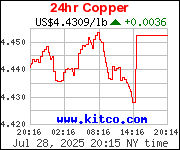
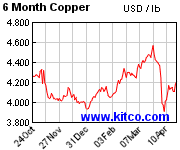
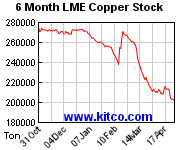
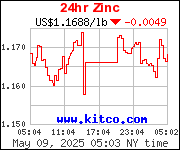
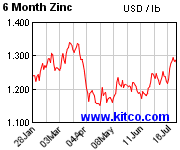
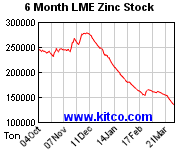
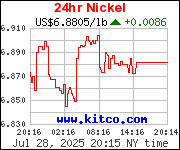
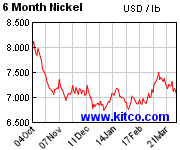
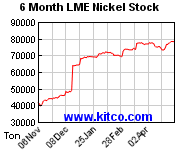
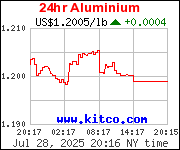
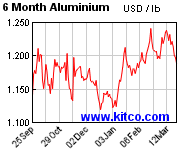
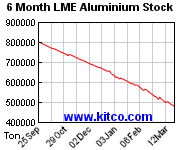
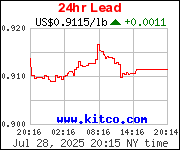
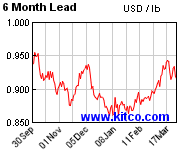
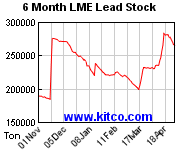
Also see: gold charts here silver charts here platinum charts here
dai oldenrich - 09 Oct 2006 07:39 - 96 of 181
Thanks guys. Keep reading - it's good for your wealth !! (I hope)
dai oldenrich - 09 Oct 2006 07:40 - 97 of 181
Bloomberg - Oct. 9
Still Like Copper, Nickel, Zinc? Buy an LME Membership Instead - By Chanyaporn Chanjaroen and Matthew Leising
The London Metal Exchange, the biggest marketplace for trading aluminum, copper, nickel and zinc, is a better investment than any of those commodities.
The price of membership has increased 72 percent to $2.03 million since May on speculation the 129-year-old exchange will sell shares to the public or be acquired. Copper and zinc fell 15 percent in the past five months and aluminum 21 percent.
Profits quadrupled this year at the LME, whose members collect a fee of 0.016 percent of the value of every contract that changes hands. The boom and bust in commodities expanded trading 21 percent to 59.1 million futures and options, or about $2 billion a day, increasing members' revenue while eliminating the risk of price fluctuations.
``You make money when the market goes up, down or sideways,'' said William Adams, chief energy and capital market strategist at LaSalle Futures Group Inc. in Chicago. Investors ``can almost look at an exchange as a trade factory,'' profiting as the number of trades rises, he said.
Shares of the Chicago Board of Trade, where daily trading in Treasuries, grains and gold reached a record in the third quarter, have more than doubled since the exchange went public a year ago. IntercontinentalExchange Inc. has risen 97 percent in nine months, and Chicago Mercantile Exchange Holdings Inc. stock has returned an average 90 percent a year since 2002.
Chicago Board of Trade Chief Executive Officer Bernard Dan will talk with LME chief Martin Abbott about a link-up at a meeting this week, the Observer reported yesterday, without saying where it obtained the information. Dan would either like to buy the LME or set up an alliance, the paper said.
2,000 Traders
Surging values of commodity exchanges follows a five-year rally in raw materials that led to all-time high prices for oil, gasoline, copper, zinc and sugar, and sent gold to a 26-year record. Demand for commodities jumped as global economic growth fueled purchases of homes, cars and appliances, particularly in China and the U.S., and producers of raw materials were unable to keep pace.
A public sale of the London Metal Exchange is likely to be discussed when 2,000 metals traders, producers and consumers gather in London for their annual convention this week. Some of the 81 member-firms may push the exchange to go public to allow them to raise cash from their investment.
``An IPO should be very carefully considered,'' said David King, who ran the LME from 1989 to 2001 and is now managing director for business development at HSBC Bank Middle East Ltd. in Dubai. ``More and more exchanges around the world are selling shares to the public to raise funds or otherwise satisfy the needs of their stakeholders.''
`Stagnating'
The exchange, which still relies on brokers shouting orders across a six-meter-wide trading floor rather than on electronic transactions, may need to sell shares to finance its inevitable switch to computers, some commodities experts said. The LME otherwise risks losing market share like the New York Mercantile Exchange has for its benchmark gold contracts.
Nymex, whose members resisted computer-based trading in favor of face-to-face transactions, lost almost half of its gold futures business to the CBOT's online gold contract. The LME needs to modernize, said Colin Griffith, chairman of the 10- month-old Dubai Gold and Commodities Exchange.
``If you look around the world, Comex and Nymex are now doing a lot more business on electronic platforms,'' Griffith said. ``The Chicago Board of Trade has come in and taken a big chunk of gold trade via its efficient electronic-trading platform. Those who are not doing that are stagnating.''
Selling the LME to investors isn't a sure thing. King's successor at the exchange, Simon Heale, said in an interview that the possibility of a public offering, or even a takeover, ``is a non-story.'' LME shares belong to those who want to trade on the LME, he said.
Beats Big Board
Heale, 53, left his position last week to make way for former publisher Martin Abbott. LME spokesman Adam Robinson said Abbott wouldn't be available to comment before the annual convention that starts today.
Growth in trading at the London exchange outpaced the 14 percent increase on the Chicago Board of Trade, the second- largest U.S. futures market, through August. The LME's two newest members are Charlotte, North Carolina-based Bank of America Corp., the U.S. second-largest bank, and the Royal Bank of Canada, or RBC, the biggest Canadian lender.
``There is demand from our customers'' for LME products, said Alex Heath, head of RBC's base metals trading desk in London, who has spent 30 years in the metals industry.
Membership Prices Jump
The surge in commodities exchanges stands in contrast with the New York Stock Exchange and other equity marketplaces that recently went public. Shares of the parent of the NYSE have declined by 1.8 percent from March 8 through September as more trading moved to rival markets. The Big Board's share of trading in its own listed stocks fell last month to a record low of 69.9 percent.
LME's so-called Class B shares, which grant the holder the right to trade on the exchange, last sold for 43 pounds ($81) each, according to its Web site. In June, the shares sold for 25 pounds each. Since Class B shares were introduced in May, 51,200 have changed hands. To be an LME member, which gives the right to issue metal contracts and clear trades, a company must hold 25,000 shares. Class A shares, which give the holder a stake in the exchange itself, haven't traded since March.
The increase in the LME share price ``reflects people's recognition of the strong cash-flow-generating characteristics of exchanges and buoyant volumes,'' said Andrew Mitchell, an analyst at Fox-Pitt, Kelton in London. ``The potential change to a profit-making model has prompted talk of an eventual initial public offering.''
Windfall Investment
Net income at the LME was 1.4 million pounds ($2.6 million) last year, up fourfold from 2004. Nymex Holdings Inc., owner of the world's largest energy marketplace, said second-quarter profit more than doubled to $38.1 million.
Daniel Dicker, who bought a Nymex seat two decades ago so he could trade commodities, says the investment has been a windfall.
``That's the irony, no one bought these because they were investments,'' said Dicker, who owns two Nymex seats and has seen one of them rise 40-fold in value and the other 20-fold. ``I feel like I put a quarter chip down on a roulette table on black and went out to dinner, and in the two hours the wheel hit nothing but black.''
Commodities exchanges now are attracting takeover offers. The New York Mercantile Exchange agreed to sell a 10 percent stake to Greenwich, Connecticut-based buyout firm General Atlantic LLC for $170 million. General Atlantic won a bidding war among investment firms such as Blackstone Group LP and Battery Ventures, as well as a group led by former Nymex chairman Michel Marks.
Past Attempts
The LME, whose members Barclays Plc and Man Group Plc, have fended off attempts to steal business. The Nymex introduced an aluminum contract in 1999, with Alcoa Inc., the world's largest producer of the metal, the first company to trade it. Today, fewer than 100 contracts change hands each day on the Nymex, compared with as many as 11,000 three-month aluminum futures contracts on the LME.
Nymex has begun shifting more of its trades online. It began offering simultaneous electronic and floor-based trading of most metals contracts on Sept. 4. Two weeks ago, about 52 percent of its energy contracts were bought and sold by computer, according to John Davidson, a managing director at the Chicago Mercantile Exchange.
CBOT on Aug. 1 began offering daytime electronic trading in grain futures for the first time in its 158 years. Nymex, in a bid to take back its market share from CBOT, offered shares and $10 million in cash to its members so it can extend electronic trading of precious metals to daytime.
Days Are `Numbered'
Investors can start buying and selling reduced-size metals contracts on the LME from Nov. 20. The contracts, called LMEminis, willallow users to trade in lots of 5 tons, compared with existing 25-ton contracts. LMEminis will only be traded electronically.
The days of floor-trading on the LME ``are severely numbered,'' Malcolm Freeman, managing director of Ambrian Commodities Ltd. in London, an LME member who has been at the exchange since joining as a 17-year-old clerk in 1974. The trading floor will probably be closed within a year, he said.
Not so, says the LME's outgoing chief Heale.
Trade in the ring ``is robust,'' Heale said. Members will have the final say on whether to keep the floor open.
``There's a transparency on the floor that trade via electronic platforms and telephone can't match,'' said Fred Demler, head of global metals trading at Man Financial Inc. in New York. Man is the LME's largest brokerage for funds.
``The LME floor has been in operation for nearly 150 years and will continue as long as customers and member firms want to,'' said Peter Sellars, president of Sempra Metals Ltd. which trades on the floor and operates an electronic trading platform.
dai oldenrich - 09 Oct 2006 07:43 - 98 of 181
Bloomberg - Oct. 9
Gold Extends Gains in Asia After North Korea's Nuclear Test - By Feiwen Rong
Gold extended gains in Asia after the North Korea said it carried out its first nuclear weapons test, boosting the precious metal's appeal as a safe investment amid geopolitical tensions.
Gold for immediate delivery rose in early trade after crude oil rebounded in New York. The bullion extended gains after the announcement by North Korea's official Korea Central News agency.
``Events such as this will boost gold's appeal,'' Ma Tianyu, a bullion trader at Bank of China, said by phone from Shanghai today. ``So far, people have not flocked to gold market yet and we are all waiting to see the event as it unfolds.''
Gold for immediate delivery rose as much as $5.1, or 0.9 percent, to $579.20 an ounce at 11:29 a.m. Singapore time.
Gold futures for December delivery rose $7.10, or 1.2 percent, to $583.90 an ounce on the Comex division of the New York Mercantile Exchange at 11:29 a.m. Singapore time.
dai oldenrich - 09 Oct 2006 07:48 - 99 of 181
Oct. 9 (Bloomberg)
Shanghai Copper Rises on Speculation Chinese Demand to Increase - By Xiao Yu
Copper in Shanghai rose after a week- long Chinese holiday on speculation demand is increasing fast enough to erode inventory in the world's biggest copper consumer.
Rising demand from processors such as electric wires and cable producers may prompt users to import more, said Li Ling, a trader at Shenzhen Star Futures Co., by phone from Shanghai today. Inventories at factories are close to zero, a signal imports may rebound, said Yang Changhua, senior analyst at Beijing Antaike Information Development Co. on Sept. 27 at a conference in eastern Nanjing city.
``October and November are the peak consumption period of the year,'' said Star Futures' Li. Processors tend to undertake maintenance in summer as households use more air-conditioning, draining power supplies for the plants.
Copper for November delivery rose as much as 1,510 yuan, or 2.2 percent, to 71,900 yuan ($9,093) a metric ton on the Shanghai Futures Exchange. The metal traded at 70,840 yuan a ton at 11:20 a.m. local time.
China's imports of copper, which rose to a record price of $8,800 a ton in May on the London Metal Exchange, fell 24 percent from January to August from a year ago, the customs office said Sept. 12. Imports have been dropping year-on-year since October 2005.
Metal for three month delivery on the LME rose as much as $65, or 0.9 percent, to $7,525 a ton. Metal traded at $7,510 at 11:12 a.m. Shanghai time.
22-Week Low
Copper stockpiles in Shanghai fell to a 22-week low as of Sept. 28 as traders brought the metal out of the exchange warehouses to meet demand in the physical market, Jiang Mingjun, a trader at Shanghai Oriental Futures Co. said Sept. 29. Stockpiles fell 9,470 tons, or 22 percent, to 33,549 tons, from the previous week.
Inventories in the LME warehouses have fallen 3,525 tons this month to 114,050 tons, Bloomberg data showed.
Metal for immediate delivery in Changjiang, Shanghai's biggest copper market, rose as much as 1.5 percent today to 71,940 yuan a ton. Chinese users have to pay 17 percent value- added tax, 2 percent import tax, premiums and freight charges for imported copper.
dai oldenrich - 10 Oct 2006 07:41 - 100 of 181
Oct. 10 (Bloomberg)
Shanghai Copper Falls as China's Growth Curbs May Hurt Demand - By Helen Yuan
Shanghai Copper futures had their biggest decline in three weeks amid speculations that government measures to curb excessive investment will hurt consumption of the metal used in piping and wiring.
Copper for November delivery fell as much as 880 yuan, or 1.3 percent, the biggest decline since Sept. 20, to 69,750 yuan ($8,826) a metric ton on the Shanghai Futures Exchange. The contract traded at 69,850 yuan at 11:30 a.m. break local time.
China, the world's biggest copper consumer, will step up efforts to avoid accelerated economic growth that may lead to overheating, Ma Kai, the nation's top economic planner, said in a statement posted on the National Development and Reform Commission's Web site yesterday. China will curb excessive growth in investment and loans and tackle the widening trade deficit in the second half, he said.
``Tighter controls on properties and other fixed-asset investments may harm metal demand,'' said Wang Zheng, a Shanghai-based metal trader with Dalu Futures Co.
Metal for three-month delivery on the London Metal Exchange fell 0.1 percent to $7,440 a ton at 12:02 p.m. Shanghai time.
Metal for immediate delivery in Changjiang, Shanghai's biggest copper market, fell as much as 1.2 percent today to 71,090 yuan a ton. Chinese users have to pay 17 percent value- added tax, premiums and freight charges for imported copper.
China's economy grew 11.3 percent in the second quarter, the fastest pace in more than a decade. The World Bank said in August failure to control investment could leave the world's fourth-largest economy with idle plants, falling profits and rising bad loans.
Lower Prices
The State Council, China's Cabinet, will soon issue new suggestions on land use and management including adjusting fees and taxes for construction purposes, Ma said.
Calyon, the investment-banking unit of Credit Agricole SA, France's second-largest bank, said copper and aluminum prices will probably average lower in 2007 compared with this year because of a ``deceleration'' in global economic growth.
Copper prices will average $6,100 a metric ton next year, down from $6,675 a ton estimated this year, Calyon analyst Michael Widmer said in a report yesterday.
Users will be forced to switch to cheaper materials after copper prices soared to records earlier this year, Peter Kettle, research director at industry consultant CRU International in London.
dai oldenrich - 11 Oct 2006 07:05 - 101 of 181
AFX
Copper prices could turn lower by end-2007 as supply rises - analyst
Copper prices, which have seen dramatic increases this year, will remain strong in the first half of next year but could turn lower after that as new supplies come on stream, said Peter Kettle, research director at mining consultancy group, CRU.
Speaking at an LME seminar, Kettle said supply is set to "catch up with demand eventually" owing to increased investment in new mining projects. "Our forecast is for balance" between supply and demand in 2007, he said. "There remain concerns about strikes and certainly there is still the possibility of another price spike early next year, but after that we see fairly large surpluses. We see a fairly sharp fall in prices," said Kettle.
He also noted that while the 'super-spike' in copper prices may have caused permanent damage to consumption patterns. "Over the next couple of years, the price effects could bend the trend downwards. Copper (consumption) might be affected by substitution. Our calculation is that losses as a result of substitution are spreading," he said.
World demand for copper suffered a bet loss of 1 pct in 2005 as users chose to use other metals, according to CRU research. "These losses are very likely permanent," said Kettle.
dai oldenrich - 11 Oct 2006 07:05 - 102 of 181
International Herald Tribune - 10 October 2006
China sets new limits on lead, zinc
China sets new limits on lead and zinc. China said Tuesday that it hoped to cap the production capacity of refined lead and zinc by 2010 to cool investment and ease raw material shortages.
The government wants to limit annual capacity of refined lead to four million metric tons and that of zinc to five million tons by closing polluting plants and restricting new projects, the State Administration of Taxation said in a statement.
dai oldenrich - 11 Oct 2006 07:05 - 103 of 181
Oct. 11 (Bloomberg)
Gold Falls After U.S. Dismisses Reported Second N. Korea Test - By Tan Hwee Ann
Gold fell in Asia, wiping out earlier gains after the U.S. dismissed a report that North Korea had conducted a second nuclear test.
The White House said no new seismic activity had been detected in North Korea. Japan's Nippon Television Network Corp. said earlier the country had detonated a second atomic bomb after North Korea reported a first test on Oct. 9. Some investors buy gold as a haven at times of political uncertainty.
``The U.S. has knocked it down, and that said, the market is back to where it was,'' Darren Heathcote, head of trading at Investec Australia, said by phone in Sydney. ``At the moment, the driver for gold is oil, which fell last night. One could expect gold to remain in the doldrums.''
Gold for immediate delivery fell as much as $1.10, or 0.2 percent, to $571.90 an ounce and was trading at $572.20 at 12.29 p.m. Sydney time. It jumped as much as $2.80, or 0.5 percent, to $575.80 following the Nippon Television report.
Gold, which some investors buy as a hedge against inflation, has dropped 22 percent from a 26-year high of $730.40 an ounce on May 12. That's in line with the 25 percent fall in New York crude oil futures from its record $78.40 a barrel on July 14.
Oil prices are trading near an eight-month low today after Saudi Arabia told customers in Europe and Asia that it will maintain shipments amid a seasonal drop in demand.
Gold for delivery in December rose as much as $3.60, or 0.6 percent, to $579.80. It was unchanged at $576.20 an ounce at 12:30 p.m. Sydney time in after-hours electronic trade on the Comex division of the New York Mercantile Exchange.
A futures contract is an obligation to buy or sell a commodity at a set price for delivery by a specific date.
dai oldenrich - 11 Oct 2006 07:06 - 104 of 181
Oct. 11 (Bloomberg)
Copper Declines in Shanghai After Codelco Signs Labor Agreement - By Xiao Yu
Copper futures in Shanghai fell for a second straight day as concern over supply disruptions eased after Codelco, the world's biggest producer of the metal, avoided a strike at its Andina unit in central Chile.
The workers at Andina, which accounts for 14 percent of Codelco's copper output, accepted the offer of a rise of 3 percentage points above inflation and a 6.4 million peso ($11,968) bonus, Codelco said yesterday in a note to the securities regulator. Government-owned Codelco will also hold wage talks this year at Chuquicamata, its largest mine, it said.
``Further supply disruptions are unlikely this year as major copper producers have increased salaries for workers,'' said Xue Feng, Shanghai-based trader at Maike Futures Co. ``Investors' concern over potential supply disruptions are easing as big producers have reached agreement with workers.''
Copper for November delivery fell as much as 340 yuan, or 0.5 percent, to 69,660 yuan ($8,799) a metric ton on the Shanghai Futures Exchange. The contract traded at 69,880 yuan at 11:30 a.m. mid-day break.
The agreement with Andina's 1,018 unionized workers follows BHP Billiton Ltd.'s decision to increase bonuses paid to workers on its Spence project in Chile last month. BHP, the world's largest mining company, also agreed to increase wages as part of a package that averted a strike on Sept. 27. Spence, which will begin operating in December, will produce 200,000 tons of copper annually at full capacity.
Metal for three month delivery on the London Metal Exchange fell $5, or 0.1 percent, to trade at $7,425 a ton at 11:02 a.m. Shanghai time.
Market Confidence
Copper for immediate delivery in Changjiang, Shanghai's biggest copper market, fell as much as 340 yuan today to 70,750 yuan a ton. Chinese users have to pay 17 percent value-added tax, premiums and freight charges for imported copper.
Copper fell partly because investors are concerned that the U.S. economy may slow down. Recent falls in gold and oil prices also affected market confidence, said Maike's Xue. A stronger dollar would make gold less attractive as investment as it is costlier for buyers holding other currencies, he said.
Gold, which is seen as a hedge against inflation, has dropped 22 percent from a 26-year high of $730.40 an ounce on May 12. That's in line with the 25 percent decline in New York crude oil futures from its record $78.40 a barrel on July 14.
Still, some traders and producers believe copper will stay high till the end of this year as demand is recovering and the U.S. economy is unlikely to go into recession, Maike's Xue said.
`Robust Demand'
Chile, the world's biggest copper producer, expects metal prices to average $3 a pound this year, amid ``robust'' demand, Karen Poniachik said in an interview in London yesterday. Copper will trade between $3.40 and $3.50 a pound through December, Poniachik said.
Copper futures for December delivery rose 0.1 percent to $3.380 a pound on the Comex division of the New York Mercantile Exchange in after-hour trade.
dai oldenrich - 11 Oct 2006 07:43 - 105 of 181
Oct 10 - (Reuters)
New York - After the Bell: Alcoa falls further
Shares of Alcoa Inc. extended their after-hours losses on Tuesday after the world's largest alumimum producer reported its third-quarter profit almost doubled, but results fell below Wall Street forecasts.
Shares were trading down 7.2 percent at $26.25 after closing at $28.29 on the New York Stock Exchange.
dai oldenrich - 12 Oct 2006 07:23 - 106 of 181
Oct. 12 (Bloomberg)
Gold Trades Near Four-Day Low as Oil's Drop Cuts Hedge Appeal - By Feiwen Rong
Gold traded its lowest in four days in Asia after a drop in energy costs reduced the appeal of the precious metal as a hedge against inflation.
Crude oil has slid 3.7 percent this week, on speculation OPEC won't enforce an output cut as demand growth slows. Gold and oil have closely tracked each other since the commodities reached highs in May and July.
``Gold is not going anywhere because of unstable and weak oil prices,'' Osamu Ikeda, general manager of precious metals division at Tanaka Kikinzoku, Japan's largest precious metal refiner, said by phone from Tokyo today.
Gold for immediate delivery traded at $573.30 an ounce at 11:49 a.m. in Sydney. It earlier fell as much as $1.20, or 0.2 percent, to $571.80 an ounce.
Some investors buy gold when energy expenses climb. Gold futures reached a record $873 an ounce in January 1980 when oil costs doubled in a year, sparking a surge in the inflation rate.
Gold has dropped 22 percent from a 26-year high of $730.40 an ounce on May 12. That's in line with the 27 percent fall in New York crude oil futures from its record $78.40 a barrel on July 14.
The Organization of Petroleum Exporting Countries, which pumps about 40 percent of the world's oil, is still debating the scale of the cut needed to stem a three-month slide in prices, Qatar's Oil Minister Abdullah bin Hamad al-Attiyah said. The International Energy Agency yesterday cut its world consumption forecast this year and next for a second month.
Gold for delivery in December rose $1, or 0.2 percent, to $577.50 an ounce at 11:52 a.m. Sydney time in after-hours electronic trade on the Comex division of the New York Mercantile Exchange.
dai oldenrich - 12 Oct 2006 07:26 - 107 of 181
12 October 2006 - People's Daily Online
World's 5th largest gold, copper reserves found in Pakistan
The world's fifth largest reserves of gold and copper were discovered in Chaghi area in Pakistan's southwest Balochistan province, local newspaper The News reported on Thursday.
Director General of Provincial Department of Mineralogy Maqbool Ahmed said that two multinationals, Canadian and Chilean-firms, which were issued licenses 10 years earlier for exploration of gold in the Bekodik area, have completed the exploration work and have chalked out a project for the extraction of gold and copper.
In the preliminary stage, the two companies will invest a billion U.S. dollars in the project, Ahmed said.
According to Ahmed, 200,000 tons of copper and 400,000 ounce of gold will be produced annually through the said project.
The Balochistan government will get a share of 25 percent. With the start of the project, employment will be provided to 3,000 youth of the province.
According to Ahmed, there are gold reserve in Zhob and Lasbela districts of the province and nine multinationals have been issued licenses for their exploration.
However, the opposition parties in the province expressing their reservations charged that federal government wishes to loot the resources of the province.
dai oldenrich - 13 Oct 2006 07:24 - 108 of 181
Oct. 13 (Bloomberg)
Gold Declines in Asia After Traders' Charts Give Sell Signals - By Feiwen Rong
Spot gold in Asia fell, reversing some of yesterday's gains, after the charts that some traders use to predict price movements gave sell signals.
Gold for immediate delivery approached a so-called resistance level at $580 an ounce yesterday, marked by clusters of orders to sell the precious metal. The commodity had gained 1.1 percent to settle at $579.30 an ounce in New York as some investors' sought a hedge against rising inflation.
Bullion ``is not running on anything other than some resistance at that level,'' Ron Cameron, a resources analyst at Ord Minnett Ltd., said by phone from Sydney today. ``The market also gets a bit cautious before the weekend.''
Gold for immediate delivery fell as much as $1.20, or 0.2 percent, to $578.10 an ounce and traded at that level at 11:25 a.m. Singapore time. Still, the metal has gained 23 percent over the past year.
``$580 is a level which if we could trade through it, it could go for a reasonably strong rally,'' Cameron said.
Crude oil rose in New York after a report showed U.S. fuel demand increased for the first time in seven weeks and heating fuel supplies fell more than expected. Oil for November delivery rose as much as 52 cents, or 0.9 percent, to $58.38 a barrel in after-hours electronic trading on the New York Mercantile Exchange. It was at $58.26 at 11:36 a.m. in Singapore.
``Gold seems to have found some support at $570 level and it's unlikely to trade below it unless oil declines,'' said Chris Kwon, gold broker at Seoul-based HanMag Refco Futures Corp.
dai oldenrich - 13 Oct 2006 07:30 - 109 of 181
Friday, October 13, 2006 - Dow Jones Newswires
Range-Bound Gold Testing Investor Patience
Gold risks pullback if it continues to tread water, as selloff by some impatient investors "might kick off a nastier dip," warns Australia's CBA bank. Spot gold last at $578.70/oz, adding $2 to modest overnight gains in line with oil, EUR/USD, although remains at upper echelons of $560-580 range. "So far, gold has stayed out of trouble by avoiding the June lows" of around $540; "the proximity of those lows is a making us nervous because, should prices fall below that level, investor patience will be tested."
dai oldenrich - 14 Oct 2006 08:17 - 110 of 181
Oct. 13 (Bloomberg)
Gold Has Biggest Weekly Gain Since July as Crude Oil Climbs - By Choy Leng Yeong and Danielle Rossingh
Gold in New York had the biggest weekly gain since July as energy costs increased, boosting the appeal of the precious metal as a hedge against inflation.
The price of gold gained 2.8 percent in the past two days as crude-oil prices climbed 1.9 percent. The metal tumbled 4.5 percent last week and is down 19 percent from a 26-year high of $732 an ounce in mid-May. Oil climbed today on signs of growing U.S. energy demand and disruptions to supplies from Norway. Prices still have slumped 25 percent from $78.40 a barrel, the highest ever, in July.
``Gold is following oil tick for tick,'' said Michael Guido, director of hedge-fund marketing at Societe Generale in New York. ``You have technical funds buying gold.''
Gold futures for December delivery rose $12.40, or 2.1 percent, to $592.70 an ounce on the Comex division of the New York Mercantile Exchange, the biggest percentage gain since Sept. 5. The weekly gain was 2.8 percent. Prices are up 14 percent in 2006 and 25 percent from a year ago.
A futures contract is an obligation to buy or sell a commodity at a set price for delivery by a specific date.
Some investors buy gold to preserve purchasing power in times of accelerating inflation. Gold futures surged to $873 in 1980, when a jump in the cost of oil led to a 13 percent annual rise in U.S. consumer prices.
``The oil price is one of the reasons gold has spiked higher,'' said Frederic Panizzutti, a senior vice president at MKS Finance, one of Switzerland's four bullion refiners.
Gold may rally in coming days on investment demand, John Reade, an analyst at UBS AG in London, said in a report.
``We are hearing more positive signs from our wealth- management colleagues about private clients' intentions and activities in gold,'' he said.
Demand for StreetTracks Gold Trust, an exchange-traded fund that is linked to the price of gold, has risen 53 percent this year. The fund has 126.4 million shares outstanding, each representing a 10th of an ounce of gold.
dai oldenrich - 14 Oct 2006 08:17 - 111 of 181
Hoovers - 13 October 2006
LME metals end mostly higher, copper down
Bullish supply-side predictions for nickel, lead and tin saw all three metals end London Metal Exchange Week in fresh record-high territory while copper remained barely changed on the week, traders said.
Technical buying buoyed nickel, tin and lead to fresh highs amidst lackluster, rangebound trading in gold, oil and currency markets.
Fresh outflows of nickel from LME warehouses encouraged aggressive buying, lifting prices to record highs for the fifth consecutive session.
Nickel broke a new high at $31,150 a ton, up $650 on previous late kerb. Prices ended London's late kerb slightly lower at $30,750/ton, up $250 on previous PM kerb levels.
Aluminium, like nickel, was subject to "fairly agressive" buying pressure which was unchallenged by selling until prices hit $2,650/ton, a trader said. Aluminium ended Friday's session up $45 on previous PM kerb at $2,635/ton.
Supply-side concerns related to three smelter closures in Indonesia helped lift LME tin to a 17-year high of $9,950/ton, albeit on thin volumes, traders said. The smelters didn't have the correct operating permits, Indonesian police said.
Lead's upside momentum carried into a fifth session, lifting prices to a fresh cycle high of $1,512/ton, on the strength of system-driven momentum buying. Prices closed shy of highs at $1,490/ton, down $2 on previous kerb levels but up 5.5% on the week.
Unlike the remainder of the complex, LME copper "closed the week still somewhat hesitant," according to Triland Metals Ltd., down $20 on previous PM kerb and unchanged on the week at $7,460/ton.
dai oldenrich - 14 Oct 2006 08:19 - 112 of 181
FT.COM - October 12 2006
Structural shifts in copper market - By Chris Flood
New institutional funds flowing into the copper market have resulted in a historic shift in the relationship between prices and stocks, according to Bloomsbury Mineral Economics (BME), the metals consultancy.
The copper market has developed into a hybrid that is part industrial metals and part investment vehicle.
Investment demand has created a virtual deficit in the futures market, equivalent to 250,000 tonnes, which acts as a more powerful influence on prices than any slight rise in inventories.
However, BME stressed there was no speculative bubble in copper prices. This was shown by the narrowing in the spread between cash and three-month prices that purely speculative flows would have increased.
Instead, coppers price behaviour had been altered by remorseless pressure from investment buying, mainly via commodity index funds that hold about $105bn in futures, equivalent to about 600,000 tonnes of the red metal.
The recent growth in the popularity of structured notes has injected another $10bn into the market, with up to 300,000 tonnes being held as call options.
BME said there was now a triple deficit stretching across the copper market from concentrates to refined metals to the futures market.
The deficit in the copper concentrates market is expected to be the largest ever in 2006 at 330,000 tonnes, due partly to weak mine production.
Mine production has been lower than expected due to supply disruptions with strike action affecting output at La Caridad, Cananea and Escondida.
BME cut its estimate for mine production this year to 14.87m tonnes from 15.22m tonnes in April. This is well below the International Copper Study Groups current forecast of 15.17m tonnes for 2006, effectively the industry consensus.
For 2007 the situation is similar, with BME forecasting output of 15.86m tonnes, down from 16.16m tonnes in April and well below the ICSG forecast of 16.20m tonnes.
BME also said the refined copper market would remain in deficit this year at 300,000 tonnes and in 2007 at 100,000 tonnes with just a tiny surplus emerging in 2008.
Chinese consumption growth in 2006 has been revised up to 2.5 per cent instead of a decline of 4 per cent. West Europe consumption is expected to increase by 9.5 per cent compared with an earlier estimate of 7.5 per cent. The slowdown in the US housing market is expected to reduce consumption by 0.7 per cent this year, whereas a rise of 1.5 per cent was previously forecast.
Strategic stockpiles of refined copper are expected to be depleted by the end of 2007 with little opportunity for rebuilding before the next global recession.
Extremely high levels of exchange stocks will be required to drag prices back towards the $3,000 level, but even with increasing levels of stocks, prices are likely to remain much higher than previously.
dai oldenrich - 14 Oct 2006 08:19 - 113 of 181
The Independent - 14 October 2006
Are the good times over for commodities market? A super-cycle was predicted, so why are commodity prices off the boil, asks James Daley
What has happened to the so-called commodities super-cycle? Six months ago, commodity experts claimed the world had entered a 15- to 20-year bull market. By May this year, the gold price had more than doubled in five years, while the price of oil and copper had risen more than fourfold over the same period. From wheat to nickel to coffee, almost all commodities at least doubled in value over five years, to this spring.
The good times were supposed to continue. And yet, suddenly, commodity prices have come off the boil, as fears of a slowdown in the US economy have given investors the jitters. The Reuters/Jeffries CRB commodity price index is now down almost 20 per cent since May, despite continued demand from Asia, supposedly the underpinning for the super-cycle.
Ian Henderson, manager of JP Morgan's Natural Resources fund, says that the past few months have been a blip. "A lot of very fast money enhanced the commodities market in 2005," he says. "My view is that [short-term movements in prices] are the wrong thing to focus on - the focus should be on what's going on in China."
Although speculating investors have helped to boost commodity prices over the past 18 months, most fund managers and analysts agree that it is the rapid growth in developing countries such as China and India that is behind the recent bull-run.
Henderson points out that the International Monetary Fund has just increased China's growth forecast to 10 per cent for both this year and next year - almost four times the rate at which the UK economy is growing. "The super-cycle argument remains as true today as it was a year ago," says Graham Birch, who heads up Blackrock Investment Management's natural-resources team and manages the Merrill Lynch Gold & General fund.
"The drivers behind it are still the industrialisation and urbanisation of big developing economies, such as China and India. With these countries growing at 8 or 9 per cent a year, they're consuming more of the world's resources.
"We've seen weakness in the market recently because the US economy has slowed down a bit. But you don't expect markets to go in straight lines. This looks like a soft patch in what is a relatively strong market."
Mark Mathias, of Dawnay Day Quantum, which runs specialist commodity investments, is convinced that the recent fall in prices has created a fantastic buying opportunity, though he dismisses the notion of a super-cycle. "The super-cycle suggests we're in a bigger cycle than normal, but commodity cycles are all like this," he says. "The last commodities bear market lasted 20 years, so it's natural that the bull market might go on just as long."
Even so, for most investors, it's sensible to allocate just a small amount of your portfolio to the sector. Commodities are a good way to diversify, as they tend to have a low correlation with other asset classes. While stock markets plummeted in 2001-2, for example, commodities made strong annual gains.
Dan Kemp, head of fund research at Williams de Bro warns that investors shouldn't get carried away because of recent strong returns: "The enthusiasm we've seen for commodities has very little to do with diversification benefits, and everything to do with the fact their prices have been going through the roof."
Graham Tuckwell, chairman of ETF Securities, says that non-specialist investors should probably begin by allocating 3 to 5 per cent of their portfolio to commodities.
dai oldenrich - 14 Oct 2006 08:19 - 114 of 181
Oct. 13 (Bloomberg)
Copper May Fall on Speculation Chinese Use Is Slowing - By Chanyaporn Chanjaroen
Copper may drop next week on speculation demand for the metal in China, the world's largest user, will slow.
Chinese copper imports fell 24 percent in the first nine months of the year to 1.5 million metric tons, the country's customs office said yesterday. Ma Kai, China's top economic planner, said Oct. 9 that the nation will step up efforts to prevent the country's booming economy from overheating.
Six of 13 analysts, investors and traders surveyed by Bloomberg yesterday forecast copper will decline next week. Three expected a gain and four predicted little change.
Chinese demand ``continues to be on the slow side and I don't expect it to pick up for the balance of 2006,'' said Warren Gelman, president of St. Louis-based trading company Kataman Metals Inc. Copper will fall next week to about $3.30 to $3.40 a pound, or $7,275 to $7,496 a ton, he said.
Copper for delivery in three months on the LME rose $20, or 0.3 percent, to $7,500 a metric ton as of 11:57 a.m. local time. It has risen 0.1 percent this week.
On the Comex division of the New York Mercantile Exchange, copper for December delivery rose 1 percent to $3.42 a pound. Copper for December delivery on the Shanghai Futures Exchange gained 0.2 percent to close at 69,910 yuan ($8,848) a ton. Chinese prices include 17 percent tax and 2 percent duty.
China accounts for a fifth of global copper demand. Imports last month were 174,931 tons, the customs office said. Imports were 226,430 tons in September last year, according to data compiled by Bloomberg.
Lost Consumption
The country probably will consume about 3.8 million tons this year, a 5.6 percent increase from a year ago, according to Beijing Antaike Information Development Co., which advises the government on industry policies.
Copper has quadrupled in the last five years, and traded on the LME at a record $8,800 a ton on May 11. Some users have switched to cheaper materials, and the resultant lost consumption may rise to 400,000 tons this year, up 77 percent from last year, Peter Kettle, research director at U.K. industry consultant CRU, said in London on Oct.9.
The 225,000 tons lost last year from substitution was 1 percent of world demand and three times what was lost in 2004, Kettle said at a seminar organized by the London Metal Exchange. Stainless steel and plastics are benefiting the most, he said in an interview.
``Damage is being done to consumption and it's probably permanent,'' he said.
dai oldenrich - 15 Oct 2006 09:35 - 115 of 181
Associated Press - October 15, 2006
Drop in commodities may hurt emerging markets - By Ellen Simon
NEW YORK Commodities had a miserable third quarter and many on Wall Street say they have further to fall. That theory was bolstered last week as oil prices sunk to their lowest level for the year.
If commodities prices do sink further, it will be bad news for emerging markets and the investors who have poured billions of dollars into them over the past three years.
Commodities prices tend to have a domino effect lower oil prices often drag down gold prices, for instance. And lower commodities prices tend to push down stocks in emerging markets such as Russia and Brazil, countries with a rich supply of oil and metals, respectively.
While many emerging markets continue to be on a tear, if the commodity bears are right, there may be plenty of pain to spread around.
While investors pulled $263 million out of gold and natural resources funds for the week that ended Oct. 4, they still have $26.9 billion in the funds, according to Bank of America Corp. Fund flows into emerging markets slowed during the same period, but investors still have $96.6 billion riding on emerging market funds, according to Bank of America.
Stephen S. Roach, Morgan Stanley's chief economist, wrote in September that the tidal wave of money that has flowed into commodities over the last three years has transformed commodities markets "from one of the best real-time gauges of economic activity" to a financial asset like any other that is, one that's susceptible to hysteria and bubbles.
"Just as return-hungry investors chased these markets on the upside, they could well run like lemmings to get out on the downside," Roach wrote.
Merrill Lynch & Co.'s chief investment strategist, Richard Bernstein, agrees, saying that cheap money and heavy borrowing inflated prices in commodities. Those prices are now 60 percent above what could be explained by fundamental supply and demand, he wrote earlier this month.
"These data suggest that September's downfall in commodities might only be the beginning of a protracted bear market," he wrote.
Other factors that pushed commodity prices higher, such as the U.S. housing boom and powerful growth in the Chinese economy, also could drive prices lower. A slowdown in the housing market is well under way, and economists expect slower growth from China as well.
The decline in home construction already has hit the lumber market, where prices recently dropped to 5-year lows. Metals used in homebuilding, such as copper, also are facing price pressure.
Roach argues that a downturn for U.S. consumers could slow business for Chinese producers. U.S. consumers continue to gobble goods made in China, which is why the U.S. trade deficit with China was a record $22 billion in August. But if American consumers were to start cutting up their charge cards, the effects would be felt in Chinese factories almost immediately.
Less use in the U.S. auto industry should affect steel, aluminum, glass and rubber demand, wrote Tobias Levkovich, Citigroup Inc.'s chief U.S. strategist.
While the argument for continued high prices for commodities is that demand will continue to grow, Levkovich points out that there's some room for supply to grow, too, with a possible increase in Saudi oil production and a recent Chevron Corp. find in the Gulf of Mexico.
If the strategists are right, investors who have seen impressive run-ups in markets such as South Africa, where stocks are up more than 25 percent for the year to date, might consider taking some money off the table and away from all the other dominos.